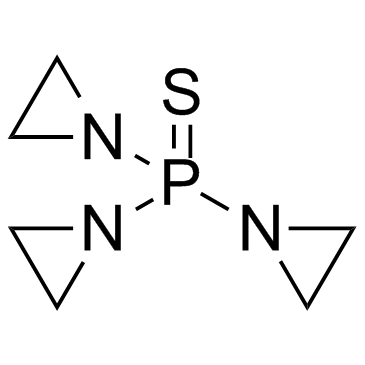Thio-TEPA

Thio-TEPA structure
|
Common Name | Thio-TEPA | ||
|---|---|---|---|---|
| CAS Number | 52-24-4 | Molecular Weight | 189.218 | |
| Density | 1.5±0.1 g/cm3 | Boiling Point | 270.2±23.0 °C at 760 mmHg | |
| Molecular Formula | C6H12N3PS | Melting Point | 54-57 °C | |
| MSDS | Chinese USA | Flash Point | 117.2±22.6 °C | |
| Symbol |


GHS06, GHS08 |
Signal Word | Danger | |
|
Cutting edge: carbohydrate profiling identifies new pathogens that interact with dendritic cell-specific ICAM-3-grabbing nonintegrin on dendritic cells.
J. Toxicol. Environ. Health A 77(22-24) , 1419-30, (2014) Dendritic cells (DC) are instrumental in handling pathogens for processing and presentation to T cells, thus eliciting an appropriate immune response. C-type lectins expressed by DC function as pathogen-recognition receptors; yet their specificity for carbohy... |
|
|
DrugBank 3.0: a comprehensive resource for 'omics' research on drugs.
Nucleic Acids Res. 39 , D1035-41., (2011) DrugBank (http://www.drugbank.ca) is a richly annotated database of drug and drug target information. It contains extensive data on the nomenclature, ontology, chemistry, structure, function, action, pharmacology, pharmacokinetics, metabolism and pharmaceutic... |
|
|
Pig-a gene mutation and micronucleated reticulocyte induction in rats exposed to tumorigenic doses of the leukemogenic agents chlorambucil, thiotepa, melphalan, and 1,3-propane sultone.
Environ. Mol. Mutagen. 55(4) , 299-308, (2014) To evaluate whether blood-based genotoxicity endpoints can provide temporal and dose-response data within the low-dose carcinogenic range that could contribute to carcinogenic mode of action (MoA) assessments, we evaluated the sensitivity of flow cytometry-ba... |
|
|
MATILDE chemotherapy regimen for primary CNS lymphoma: results at a median follow-up of 12 years.
Neurology 82(15) , 1370-3, (2014) We report updated results at a median follow-up of 12 years of a phase II trial assessing first-line MATILDE chemotherapy and response-tailored radiotherapy in patients with primary CNS lymphomas (PCNSL).Forty-one HIV-negative patients (18-70 years; Eastern C... |
|
|
Phase 2 trial of high-dose rituximab with high-dose cytarabine mobilization therapy and high-dose thiotepa, busulfan, and cyclophosphamide autologous stem cell transplantation in patients with central nervous system involvement by non-Hodgkin lymphoma.
Cancer 121(2) , 226-33, (2015) High-dose thiotepa, busulfan, and cyclophosphamide (TBC) with autologous stem cell transplantation (ASCT) has been used in patients with central nervous system (CNS) involvement by non-Hodgkin lymphoma (NHL). Despite limited penetration into the CNS, rituxima... |
|
|
Treosulfan-thiotepa-fludarabine-based conditioning regimen for allogeneic transplantation in patients with thalassemia major: a single-center experience from north India.
Biol. Blood Marrow Transplant. 19(3) , 492-5, (2013) Hematopoietic stem cell transplantation (HSCT) is the definite treatment for patients with thalassemia major. A busulfan (Bu) and cyclophosphamide (Cy)-based regimen has been the standard myeloablative chemotherapy, but it is associated with higher treatment-... |
|
|
High-dose busulfan-thiotepa with autologous stem cell transplantation followed by posterior fossa irradiation in young children with classical or incompletely resected medulloblastoma.
Pediatr. Blood Cancer 61(5) , 907-12, (2014) The aim of the study is to evaluate the outcome of young children with high risk localized medulloblastomas (newly diagnosed classical or incompletely resected) treated by high-dose busulfan-thiotepa with autologous stem cell rescue (ASCT) followed by focal r... |
|
|
Comparison of two different conditioning regimens before autologous transplantation for children with high-risk neuroblastoma.
Anticancer Res. 32(12) , 5527-33, (2012) Although high-dose chemotherapy (HDC) represents the standard of treatment for high-risk neuroblastoma (NBL), the most effective conditioning regimen still remains to be identified.Forty-one high-risk NBL entered into local protocol based on induction chemoth... |
|
|
Phase II trial of clofarabine with topotecan, vinorelbine, and thiotepa in pediatric patients with relapsed or refractory acute leukemia.
Pediatr. Blood Cancer 61(3) , 431-5, (2014) Outcomes for children with relapsed/refractory (R/R) acute lymphoblastic leukemia (ALL) and acute myelogenous leukemia (AML) are dismal. In an effort to improve outcomes, we performed a phase I/II study of a novel clofarabine based combination regimen called ... |
|
|
Radiation-free allogeneic conditioning with fludarabine, carmustine, and thiotepa for acute lymphoblastic leukemia and other hematologic malignancies necessitating enhanced central nervous system activity.
Biol. Blood Marrow Transplant. 18(9) , 1430-7, (2012) Total body irradiation has been the mainstay of conditioning since the inception of allogeneic hematopoietic cell transplantation, but toxicity often precludes its use. For less-fit patients with acute lymphoblastic leukemia and other hematologic malignancies... |